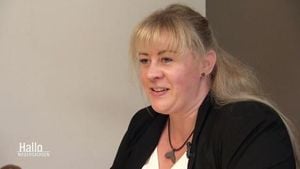The Brazilian Amazon rainforest, often referred to as the "lungs of the Earth," faces unprecedented threats from deforestation, poverty, and land grabbing practices that not only threaten the rich biodiversity of the region but also the livelihoods of millions of people living in and around this vital ecosystem. Recent reports shed light on how rampant deforestation, primarily driven by agriculture and economic exploitation, has devastating impacts that reach far beyond Brazil’s borders, linking local poverty with global environmental sustainability.
Located primarily in the northern part of Brazil, the Amazon spans over 2.1 million square miles, home to an incredible array of plant and animal species. Despite its ecological importance, the region is under siege as vast swathes of forest are cleared for cattle ranching, soybean production, and other agricultural activities, all contributing to a cycle of environmental degradation that is difficult to reverse.
In the municipality of Altamira, Pará state, a disheartening tale unfolds. A warehouse built 15 years ago to host a farmers’ market remains empty due to a lack of viable agricultural products. Locals are turning their backs on traditional farming, often opting for lumber mills or mines instead. An anonymous local lamented, "There’s nothing to sell because nobody wants to be farmers anymore.” This sentiment echoes the tragic irony of a land once rich in resources now rendered barren due to unsustainable practices.
Satellite imagery has recorded unprecedented deforestation trends, with the largest continuous area of the Amazon clearing to date identified in 2020. According to MapBiomas, an alarming 6,469 hectares were illegally cleared, much of it federal land appropriated by land grabbers. Deforestation is not just an environmental issue; it signifies the socio-economic pressures faced by local populations who fight to survive in a rapidly changing climate.
The findings reveal a disconcerting pattern: the Amazon is severely affected by economic inequalities exacerbated by poverty. Local farmers, eager to improve their livelihoods, often clear new land to cultivate crops after exhausting the soil of nutrients in previously cleared areas. "The biodiversity is rich, but so many people are very poor," explains Judson Ferreira Valentim, a soil scientist who emphasizes the need to address poverty to protect the Amazon.
One of the key drivers behind this land appropriation is the expansion of the soybean industry, which has proliferated in regions like southeastern Pará, now likened to a cancer spreading across the landscape. The economic elites in the area profit from this industrial process—sometimes at the direct cost of ecological disaster. Marcelo Reis, head of the state rural development agency, compared the expansion of soybeans to an addiction from which there is no recovery.
Despite two federal operations targeting major deforesters, illegal practices persist. The notorious “Day of Fire” incident in 2019 led to the rapid and coordinated ignition of wildfires by local farm owners, triggering international condemnation. Following this, Greenpeace unearthed new land clearing practices characterized by rapid developments over short periods. The sheer scale of destruction is mind-boggling, resulting in the loss of over 3.5 million trees and substantial declines in wildlife populations.
Among the key players implicated in this destruction are three men identified by Brazil’s environmental protection agency, IBAMA. Their operations highlight a deep-seated culture of impunity that aids illegal land grabbing in the region. One individual, Jeferson de Andrade Rodrigues, caught the attention of authorities due to his ongoing involvement and illegal fine history. His extensive impacts on forest areas, coupled with his burgeoning cattle operations, underscore a troubling trend where personal profit eclipses environmental responsibility.
As the government attempts to reinstate stricter environmental protections, those deeply entrenched in land-grabbing practices often find loopholes to continue their operations. Land grabbing serves as a means to legally bring more land into production markets, shifting the burden of ecological degradation onto the next generation as these practices further deplete soil quality and forest resources.
The issues at hand not only represent a struggle to conserve the Amazon rainforest but also reveal a desperate search for sustainable livelihood solutions among local communities. They rely on the forest's resources but, at the same time, suffer from the economic precarity that drives them to destroy what they depend on.
Emerging research emphasizes that agricultural practices must evolve to help local families adapt without destroying the rainforest. Alternatives include improving the efficiency of already cleared lands and increasing the use of native products like cacao and açaí, which provide incomes without cutting trees. Reports reveal abandoned farmlands larger than Portugal lie across the Amazon, a testament to unsustainable agricultural practices leaving soil impoverished and unproductive.
Community leaders and local farmers are beginning to recognize innovative growth practices that could sustain their livelihoods while also aiding forest conservation. Examples include using nitrogen-fixing legumes, such as forage peanuts, that enhance soil fertility and cattle productivity—a critical merger for improving food security while reducing deforestation. “You have to enforce laws against deforestation, but that’s only part of the solution. You also have to give people alternatives,” said Rachael Garrett, a researcher focused on integrated farming solutions.
Successful efforts are already underway. Local farmers who have integrated these practices are witnessing firsthand improvements in soil health and crop yields. Many are turning to the production of sustainable products that allow them to profit through eco-friendly means. For instance, César De Mendes has launched a business centered on sustainably harvested cacao, appealing to eco-conscious consumers by emphasizing how rainforest fruit harvesting can occur without deforestation.
The adoption of crop rotation and innovative grazing techniques has allowed some ranchers to increase livestock productivity significantly on their plots. Commitment to sustainable practices within communities is critical to fostering a healthier relationship with the surrounding forests, ultimately leading to mutual benefits for the population and the environment.
However, implementing these changes often requires overcoming significant infrastructure challenges in the Amazon. Poor roads and limited access to markets inhibit farmers from effectively distributing their products, worsening food insecurity. The reliance on illegal practices, such as drug trafficking and logging, complicates these local economies further.
Efforts to mitigate the devastation are hugely dependent on the government’s political will to enforce existing environmental laws and promote sustainable development. As President Luiz Inácio Lula da Silva's administration emphasizes stricter environmental regulations—reversing the prior administration's lenient approach—the battle for sustainable practices remains critical.
In the quest to save the Amazon, the interconnectedness of environmental health and human livelihoods cannot be overlooked. Addressing the economic realities faced by residents living on the rainforest's edge is essential for effective conservation strategies. As the survival of both the Amazon ecosystem and its inhabitants hangs in the balance, the urgency for comprehensive, inclusive strategies has never been more apparent.
In sum, the Amazon's fate remains intricately linked to the socioeconomic conditions of those who inhabit it. Protecting this ecological treasure requires not just preserving its environment but also recognizing the needs and rights of the people who call it home. Actions taken today can yield benefits for both the local populations and the global community, emphasizing that a sustainable future is not merely a hope but an attainable reality.



